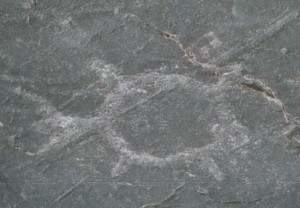by Jack El-Hai, Wonders & Marvels contributor
The Upper Midwest of the U.S. is not well known for its archaeological treasures, and it’s easy to see why. The region has utterly transformed over the past 200 years through the loss of 99 percent of its tall grass prairie, the felling of most of its original forests, and the harnessing of much of the land for agriculture.
But each spring’s snow thaw in Minnesota brings the reappearance of one of the nation’s most beautiful historic sites. Near the town of Jeffers in the southwestern part of the state is a remarkable collection of Native American petroglyphs — rock carvings — the oldest of which date back more than 7,000 years. Managed by the Minnesota Historical Society, the Jeffers Petroglyphs site and visitors center is open from May through September.
For thousands of years, native people from a wide area have been visiting this site on spiritual pilgrimages and to leave carvings on portions of a 23-mile-long outcropping of red quartzite, a bedrock deposit more than 1.6 billion years old.
The visitors center is worth seeing first. An almost wordless multimedia presentation offers scenes of the petroglyphs site in centuries past, showing the activities of native visitors during night and day. Small exhibits cover prairie ecology, the cultural significance of the bison, and the original uses of various Indian artifacts.
To view the petroglyphs, you follow a trail through a restoration of native prairie, converted from farmland 40 years ago. It includes the prairie bush clover and other examples of endangered grasses and plants — a total of more than 200 species. A few minutes of walking brings you to the petroglyphs.
Here, with the big sky above, the smell of the prairie in your nose, and the sight of acres of sloping red quartzite at your feet, you really feel as though you are in a place of spiritual importance. It’s how you would imagine a visit to Stonehenge feels — a site in the middle of nowhere that conveys a sense of being at the center of things. A roped trail leads you across the rock, which is noticeably scratched by the passage of glaciers. The degree of cloudiness in the sky, angle of the sunlight, and wetness of the rock determine which of the approximately 2,000 carvings at Jeffers are most easily seen at a given time.
Appearing between patches of lime-green and black lichen, the rock carvings depict thunderbird tracks, buffalo, atlatls, turtles, deer, hands, human profiles, and narratives that might tell tales of hunts. Because of the hardness of the rock, the larger and deeper carvings must have required extended or repeated visits by their makers. Nobody knows which Native American groups made the earliest carvings. In recent centuries, members of the Dakota tribes inhabited the area, and it’s possible that the Ioway, Otoe, and Cheyenne did as well. The site and its carvings still carry spiritual significance for Native Americans in the region.
On the way back to the visitors center, you can follow the northern loop of the trail, which passes by buffalo rubbing rocks, large quartzite boulders burnished to a glassy sheen by the rubbings of countless bison over 10,000 years.
This unforgettable site is too little known, even among those who live in the Upper Midwest. It offers a glimpse into the minds and hearts of people who left a permanent imprint on the land they loved.
Recommended reading:
Callahan, Kevin L. The Jeffers Petroglyphs: Native American Rock Art on the Midwestern Plains. Prairie Smoke Press, 2004.
Kennedy, Frances H. (editor). American Indian Places: A Historical Guidebook. Houghton Mifflin Harcourt, 2008.

